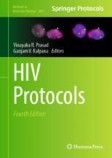Search
Search Results
-
Molecular mechanisms by which the HIV-1 latent reservoir is established and therapeutic strategies for its elimination
The human immunodeficiency virus type 1 (HIV-1) reservoir, composed of cells harboring the latent, integrated virus, is not eliminated by...

-
Single-Cell Single-Molecule RNA-FISH Combined with Immunofluorescence and High-Speed and High-Resolution Scanning Analysis to Visualize the Reactivation of Latent HIV-1
Latent HIV-1 reservoirsHIV-1 reservoirs are a major obstacle to the eradication of HIV-1. Several cure strategies have been proposed to eliminate...
-
An Ultrasensitive p24 Assay to Measure HIV-1 in Diverse Biological Matrixes
Assays to study HIV persistence are crucial to evaluate therapeutic strategies aimed toward an HIV cure. Several assays have been developed to date...
-
Molecular Mechanisms of HIV-1 Latency from a Chromatin and Epigenetic Perspective
Purpose of ReviewThe main obstacle to an HIV-1 cure is the reservoir of HIV-1 infected cells. While antiretroviral therapy (ART) eliminates the HIV-1...

-
Recovery of Latent HIV-1 from Brain Tissue by Adoptive Cell Transfer in Virally Suppressed Humanized Mice
Defining the latent human immunodeficiency virus type 1 (HIV-1) burden in the human brain during progressive infection is limited by sample access....

-
The cell biology of HIV-1 latency and rebound
Transcriptionally latent forms of replication-competent proviruses, present primarily in a small subset of memory CD4 + T cells, pose the primary...

-
Multimeric immunotherapeutic complexes activating natural killer cells towards HIV-1 cure
BackgroundCombination antiretroviral therapy (cART) has dramatically extended the life expectancy of people living with HIV-1 and improved their...

-
Bispecific antibodies promote natural killer cell-mediated elimination of HIV-1 reservoir cells
The persistence of CD4 + T cells carrying latent human immunodeficiency virus-1 (HIV-1) proviruses is the main barrier to a cure. New therapeutics to...

-
Ripretinib inhibits HIV-1 transcription through modulation of PI3K-AKT-mTOR
Despite the effectiveness of antiretroviral therapy (ART) in prolonging the lifespan of individuals infected with HIV-1, it does not offer a cure for...

-
Brain HIV-1 latently-infected reservoirs targeted by the suicide gene strategy
Reducing the pool of HIV-1 reservoirs in patients is a must to achieve functional cure. The most prominent HIV-1 cell reservoirs are resting CD4 + T...

-
Occludin: a gatekeeper of brain Infection by HIV-1
Compromised structure and function of the blood-brain barrier (BBB) is one of the pathological hallmarks of brain infection by HIV-1. BBB damage...

-
Limited HIV-associated neuropathologies and lack of immune activation in sub-saharan African individuals with late-stage subtype C HIV-1 infection
Although previous studies have suggested that subtype B HIV-1 proviruses in the brain are associated with physiological changes and immune activation...

-
Modeling HIV-1 infection and NeuroHIV in hiPSCs-derived cerebral organoid cultures
The human immunodeficiency virus (HIV) epidemic is an ongoing global health problem affecting 38 million people worldwide with nearly 1.6 million new...

-
Defective HIV-1 genomes and their potential impact on HIV pathogenesis
Defective HIV-1 proviruses represent a population of viral genomes that are selected for by immune pressures, and clonally expanded to dominate the...

-
Pericyte infection by HIV-1: a fatal attraction
While HIV-1 is primarily an infection of CD4 + T cells, there is an emerging interest towards understanding how infection of other cell types can...

-
Repression of HIV-1 reactivation mediated by CRISPR/dCas9-KRAB in lymphoid and myeloid cell models
BackgroundDespite antiretroviral treatment efficacy, it does not lead to the complete eradication of HIV infection. Consequently, reactivation of the...

-
Reduced and highly diverse peripheral HIV-1 reservoir in virally suppressed patients infected with non-B HIV-1 strains in Uganda
BackgroundOur understanding of the peripheral human immunodeficiency virus type 1 (HIV-1) reservoir is strongly biased towards subtype B HIV-1...

-
Neuropathogenesis of HIV-1: insights from across the spectrum of acute through long-term treated infection
This review outlines the neuropathogenesis of HIV, from initial HIV entry into the central nervous system (CNS) to chronic infection, focusing on key...

-
Occludin Regulates HIV-1 Infection by Modulation of the Interferon Stimulated OAS Gene Family
HIV-1-associated blood brain barrier (BBB) alterations and neurocognitive disorders are frequent clinical manifestations in HIV-1 infected patients....

-
Inhibition of caspase pathways limits CD4+ T cell loss and restores host anti-retroviral function in HIV-1 infected humanized mice with augmented lymphoid tissue
The study of HIV infection and pathogenicity in physical reservoirs requires a biologically relevant model. The human immune system (HIS) mouse is an...

